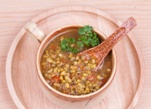 Now here’s a healing food you don’t often hear about: mung beans. Mung beans are commonly used in Southeast Asian cuisine. Mung beans are a versatile food, used in all sorts of different recipes, from main dishes, to healing soups, and even desserts.
Now here’s a healing food you don’t often hear about: mung beans. Mung beans are commonly used in Southeast Asian cuisine. Mung beans are a versatile food, used in all sorts of different recipes, from main dishes, to healing soups, and even desserts.
What makes this small bean a staple of the Asian diet? It’s a nutritious food low in saturated fat and sodium, and very low in cholesterol. It’s also a popular food because it makes a good vegetarian source of protein. As for vitamins and minerals, mung beans contain thiamin, niacin, vitamin B6, pantothenic acid, iron, magnesium, phosphorus, and potassium. And—we’re not done yet—mung beans are a very good source of dietary fiber, vitamin C, vitamin K, riboflavin, folate, copper, and manganese.
Researchers at the China Agricultural University in Beijing have noted that mung bean soup has been traditionally taken as a kind of health food in China. To learn the mechanisms underlying its health benefits, the researchers measured the antioxidant capacities of the soup. They found there were two major flavonoids called “vitexin” and “isovitexin,” respectively. Both vitexin and isovitexin are potent defenders of cellular health as they search out and scavenge free radicals.
In Ayurvedic medicine (an ancient Indian practice), mung bean soup is known for its powerful effect. The soup usually contains a number of healthy spices that up its nutritional value and healing effects.
RECOMMENDED: Health Secrets from the “Healing Tree”
When combined with certain herbs, the soup is thought to be able to remove toxic mucus that the body accumulates over time due to poor diet, lack of exercise, and an unhealthy lifestyle.
